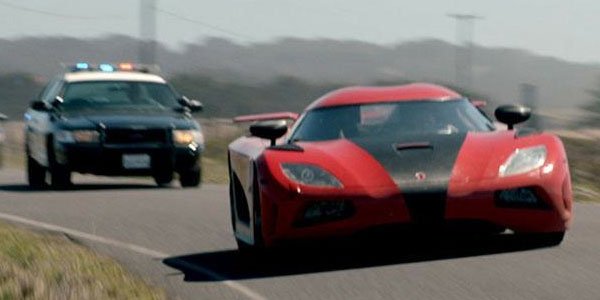To 3D Or Not To 3D: Buy The Right Need For Speed Ticket

Inspired by Electronic Arts' popular car race video game series, Need For Speed stars Breaking Bad's Aaron Paul as an illegal street racer who might be the best in the U.S. But when he's thrown in prison for a crime he didn't commit, his dreams of racing fame are put on hold. After serving his time, he speeds across the country to join the race of his dreams, where he could earn both redemption and revenge.
Our theatrical review will weigh in on whether or not this new release is worth your time, while this column will focus solely on the film's use of 3D. Considering seven separate categories, To 3D Or Not To 3D evaluates the full scope of the 3D viewing experience. Think of it as a consumer's guide for your movie-going, complete with a viewers poll where you can weigh in on how you plan to see Need For Speed.
Fit Score
5/5
Hands down, yes. While there's the essential moody moments and a romantic subplot, Need for Speed is built mainly to throw audiences into the high-octane action of dangerous street racing. And it shows.
Planning & Effort Score
5/5
CINEMABLEND NEWSLETTER
Your Daily Blend of Entertainment News
Because of the backlash movie audiences have had against post-converted 3D, studios tend to shy away from identifying a movie as such. Often, a post-convert of this nature signals a late-in-the-game decision to go 3D, which can result in catastrophes of Clash of the Titans and The Last Airbender proportions.
Need For Speed producers announced the film's post-conversion to 3D a little over month before its opening weekend. Which seems a bad sign, right? But I'll tell you this: I was astonished to learn the 3D was created in post because it's spectacular. Though it wasn't shot in stereo, none of the work seems ill planned or without incredible effort. I'm pretty sure this is the only time I've given post-converted 3D a 5 out of 5 here.
Before the Window Score
4/5
This is that flashy 3D element that makes the movie appear to come out into the theater. With plenty of screaming metal, car chases and jaw-dropping crashes, there's lots of things to throw out at audience members, like flames, shattered glass, and at one point the snarling snout of an enrage Rottweiler. (For those concerned, the Rottweiler is not harmed.) All this makes for an engaging experience that actually had me lurching back into my seat!
Beyond the Window Score
5/5
The other side of 3D is the enhanced depth of field provided beyond the window, where it appears the world of the movie is stretching out into the screen.
Director Scott Waugh was dedicated to favoring practical stunts over CGI, and it gives Need for Speed a sickening sense of realness, which is only enhanced by the 3D. As Aaron Paul ricochets from one set piece to the next, we're offered views of desolate deserts, bustling cities, and scenic seaside routes. Each one gets a pronounced depth that is striking. But where this element of 3D really stands out is in one action sequence in particular. I won't go into spoilers, but let me say this: If you are even remotely afraid of heights, you will probably freak out here. The 3D was so believable that even though my mind insisted, "it's just a movie!" I had to turn away…and maybe screech a little.
Brightness Score
4/5
This is a place that post-converts do tend to trip up. When a cinematographer is deciding on the light levels for a scene in a 2D movie, he's considering mood, and what must be visible in the frame. With 3D, he also needs to consider how those clunky glasses will take down the brightness a few notches. As much of the movie takes place during the day, this wasn't much of an issue for Need for Speed. However, there was one scene where I did catch myself squinting.
Glasses Off Score
5/5
This is a simple test. Take off your 3D glasses. Observe how blurry the movie is without them. Put them back on, and see everything pop once more. It's essentially the simplest way to see how much 3D you're getting, as the blurriness of the screen is an indicator of how many levels of depth you're actually looking at through the glasses. Impressively, every frame of Need for Speed I tested was abundant in 3D planes. Even the credits--which were just white text on a black background managed to pop off the screen.
Audience Health Score
5/5
Bad 3D can actually be bad for you, causing headaches, eyestrain, or even motion sickness when filmmakers fail to establish clear focal points for the audience. These are issues I most often run into in post-converted 3D movies, where the device clashes with cinematography that would have worked better in 2D. But once again, Need for Speed's team knew how to handle this upgrade to 3D. I was shaken up because of the frightening sensation of being in repeated virtual car crashes. But beyond that, I was fine.
3D SCORES RECAP
3D Fit
5
P & E
5
Before The Window
4
Beyond The Window
5
Brightness
4
Glasses Off Test
5
Audience Health
5
Total Score
33/35
Final Verdict: It should be pretty obvious. Need for Speed has incredible 3D. It's so good in fact, that I assumed watching it that it must have been shot in stereo. But nope, Waugh and his team just did an amazing job with the conversion. Really, this should be a movie other productions considering post-conversion look to as a shining example. It even made me reconsider my stance of instantly grousing every time such a postproduction plan is announced.
This poll is no longer available.
Click to visit our full To 3D Or Not To 3D Archive.
Staff writer at CinemaBlend.
Most Popular





